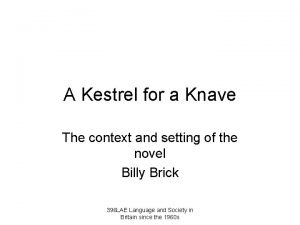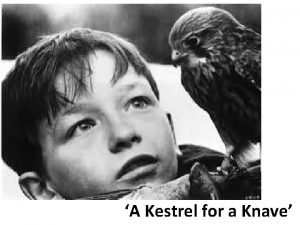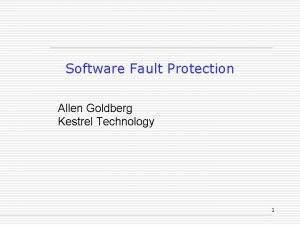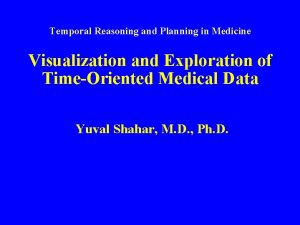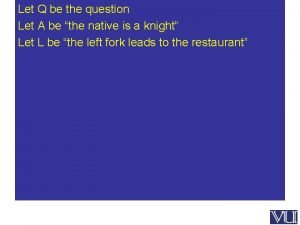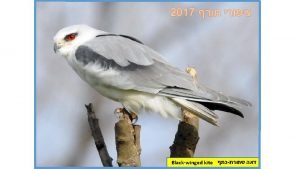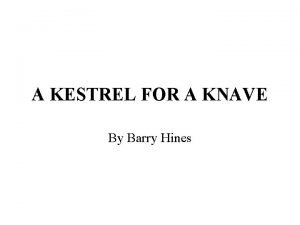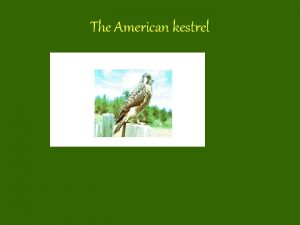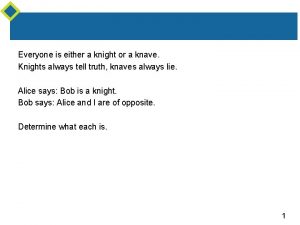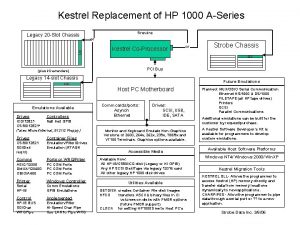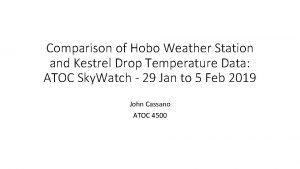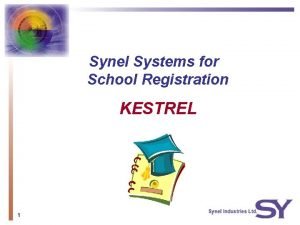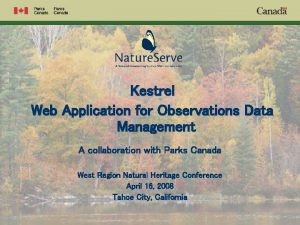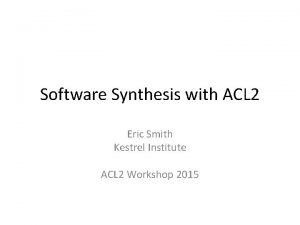A Kestrel for a Knave rs e v





























- Slides: 29

‘A Kestrel for a Knave’

rs e v o c e h t o d What u o y o t t s e g g su s e m e h t t abou s i h t f o t n e t n and co classic novel?

‘A Kestrel for a Knave’ Barry Hines ‘A Kestrel for a Knave’ tells the story of a day in the life of Billy Casper. The story is written in the third person, but there is little doubt that we are encouraged to look through Billy’s eyes. The setting is South Yorkshire in the 1960 s – probably Barnsley – though Hines never names places. We know the town is in a mining area: Billy’s brother Jud works down the pit, a fate that Billy wants to avoid, but the reader feels that inevitably he will not succeed. For boys like Billy, there was little else available. The novel has several flashbacks that move away from the action of the day and fill in gaps from the past, such as how Billy came by Kes and trained her. Billy lives with his feckless mother, Mrs Casper, and his brutal brother, Jud. It is not a loving home and Billy is not well provided for. He does, however, have his kestrel, Kes; she is the centre of his life and he dedicates all his time and efforts to her.

This is the first GCSE English Language Paper you will complete


SECTION A: READING Q 4 20 marks 4 marks Q 1 Read the text Q 2 8 marks Q 3

AO 1: Identify and interpret explicit and implicit information and ideas. Select and synthesise evidence from different texts. AO 2: Explain, comment on and analyse how writers use language to achieve effects and influence readers, using relevant subject terminology to support their views

What do you think you should read first in the exam? The ? t c a r t x e The questions?

Q 3: You now need to thin e n i l o t k about oth 7 1 source. The e inhole o text is frothme textract fr melw fptrheesent t h a o e l t i o a e has t. Lhoeow p t r enngu drest haenov i n n e g i g o k a f r i t e : a l 2 eill. ly. Haonwd e r Q B , s readero? w does theucwturirtedr uths e textotobrio eers h t n t e r w H t. t y: ou as a he 50 t n e e w t e f b o You coeulladtiw p e i c h i s o n h o c s ’ rite about: de the writer the r. Q 1 Read again incluthe first part of the source, • what Ythoeu w d l u o c riter focuhsreasses Jud? beginning. Words and p linesyo 1 -ur 17 attteecnhtnioiqnuoens d at the • List four thingsfyou nabout a s e r u t a e learn Billy (4 marks) • how and. Lawnguage hy the wrim • extract dev. Seentence fortesr changes this fo cus as the lops h c e • e p s t c e r i • any other. Tshe use of d tructural fe(a 8 marks) • tures that in terest you. (8 marks)

Let’s read…

Q 1 Read again the first part of the source, lines 1 - 17 List four things you learn about Billy (4 marks)

Bonus Question! Read the extract from Great Expectations… Q 1 Read again the first part of the source, lines 1 - 13 • List four things you learn about Pip (4 marks)

What is this passage about? What do we learn about th e characters an d their family life?

Q 2: Look in detail at the extract from line 17 to line 50 How does the writer use language here to present the relationship between the two brothers, Billy and Jud? (8 marks) You could include the writer’s choice of: • Words and phrases • Language features and techniques • Sentence forms • The use of direct speech

And what about the highest marks- what do you need to do? What should you do to aim higher? What are the key words?

Q W } One of the ways Hines presents the relationship is. . Another way the writer shows there relationship. . . The writer suggests. . . The writer presents Billy as … E This is shown when it says, “___”. . . An example of this is when Hines writes, “___”. . . For example, “___” R This makes the reader think. . . This suggests to the reader. . . The reader will think. . . This implies. . . This suggests. . . T Y The use of adjectives. . . The use of the verbs. . . The repetition of. . . This word has strong connotations of. . . This suggests. . . This implies. . . This links to. . .

Q 3: You now need to think about the whole of the source

What is structure? Structure

Beginnings and Endings Where are we placed? What emotion is triggered? What thought is offered? What direction is set? What do we walk away with? What are we left to consider? Have we journeyed somewhere or stayed in the same place?

Contrast Are there any opposites that are placed side by side for emphasis? Is there any contrast between a character, place or idea at one point in the poem and then later? (the before/after effect)

Central images, ideas, settings Is the text structured around a central image or idea? This image may be described in great detail. Perhaps an extended metaphor or symbol. Or perhaps the setting is the key thing that provides a structure for the writer to develop his/her ideas?

Distinct sections / Pivotal moments Is it clear that there are sections to this text that have been chosen by the writer on purpose? What do each of these sections reveal / represent? Is there a pivotal moment, a hinge, that seems to move the ideas in a new direction?

Build up of ideas, image, feeling What is the build up? Where is it heading? What grows over the course of the text? How does it grow?

Passages of time How is time presented in the text? Present tense, past tense? Days, weeks, years? History, present day, future?

Movement (sentence types / punctuation) What about sentence types? Are there many short ones? Long ones? A ‘stand out’ short or long sentence that marks something. Simple vs complex? Look at the punctuation. Why does it stop where it does? Are commas used to make lists – this may speed things up. Does it seem ‘choppy’ or more smooth? What punctuation is creating that effect?

Voice Who is speaking? What perspective are we offered? Who is the voice talking to? Is there more than one voice? Is the tone the same or different? Why are they speaking? Can they be trusted? Is it first, second, third person? What’s the impact? Is there any direct speech? What is the effect of this?

What is structure? • The writer chose a structure and form on purpose – it has meaning. • The examiner is not interested in a list of techniques – you need to make meaningful connections. Why has the writer chosen this technique?

What are the key words? What do es the examine r want yo u to do?

Q W E R T Y } One of the ways Hines structures the chapter is. . . The opening sentence/ paragraph is. . . The writer begins by telling us about. . . Another structural point is … At the start of the extract we are told. . This is shown when it says, “___”. . . An example of this is when Hineswrites, “___”. . . For example, “___” This makes the reader think. . . This suggests to the reader. . . The reader will think. . . This implies. . . This suggests. . . The opening sentence… The writer uses repetition to…The use of the paragraphs. . . The repetition of. . . This setting… The use of time…The shift in focus from…to… The use of the direct speech. . . This links to. . . This connects to. . . This builds an atmosphere of. . .
 A kestrel for a knave
A kestrel for a knave A kestrel for a knave
A kestrel for a knave A kestrel for a knave poem
A kestrel for a knave poem Kestrel technology
Kestrel technology Knave 2e
Knave 2e Knave bb
Knave bb Bris för vuxna
Bris för vuxna Smärtskolan kunskap för livet
Smärtskolan kunskap för livet Trög för kemist
Trög för kemist Argument för teckenspråk som minoritetsspråk
Argument för teckenspråk som minoritetsspråk Samlade siffror för tryck
Samlade siffror för tryck Delegerande ledarskap
Delegerande ledarskap Ellika andolf
Ellika andolf Returpilarna
Returpilarna Toppslätskivling dos
Toppslätskivling dos Redogör för vad psykologi är
Redogör för vad psykologi är Bra mat för unga idrottare
Bra mat för unga idrottare Lek med geometriska former
Lek med geometriska former Publik sektor
Publik sektor Ledarskapsteorier
Ledarskapsteorier Datorkunskap för nybörjare
Datorkunskap för nybörjare Mantel för kvinnor i antikens rom
Mantel för kvinnor i antikens rom Personlig tidbok
Personlig tidbok Steg för steg rita
Steg för steg rita Fspos
Fspos Orubbliga rättigheter
Orubbliga rättigheter Ministerstyre för och nackdelar
Ministerstyre för och nackdelar Claes martinsson
Claes martinsson Sju principer för tillitsbaserad styrning
Sju principer för tillitsbaserad styrning Plats för toran ark
Plats för toran ark

